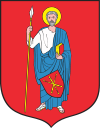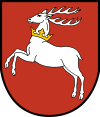Zamość
| Zamość | |||
|---|---|---|---|
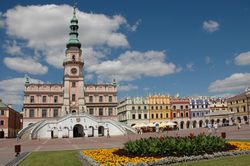 |
|||
|
|||
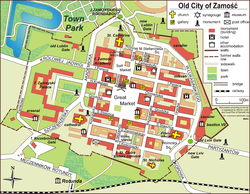 |
|||
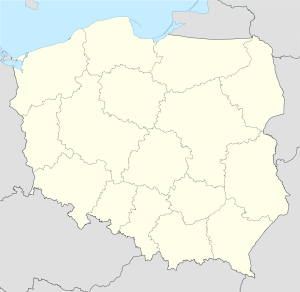 Zamość
|
|||
| Coordinates: | |||
| Country | |||
| Voivodeship | Lublin | ||
| Powiat | City County | ||
| Gmina | Zamość | ||
| Established | 1580 | ||
| Town rights | 1580 | ||
| Government | |||
| - Mayor | Marcin Zamoyski | ||
| Area | |||
| - City | 30.34 km2 (11.7 sq mi) | ||
| Elevation | 212 m (696 ft) | ||
| Population (2006) | |||
| - City | 66,613 | ||
| - Density | 2,195.6/km2 (5,686.4/sq mi) | ||
| - Metro | 140 274 | ||
| Time zone | CET (UTC+1) | ||
| - Summer (DST) | CEST (UTC+2) | ||
| Postal code | 22-400 to 22-410 | ||
| Area code(s) | +48 084 | ||
| Car plates | LZ | ||
| Website | http://www.zamosc.pl | ||
| Old City of Zamość* | |
|---|---|
| UNESCO World Heritage Site | |
|
|
|
| State Party | |
| Type | Cultural |
| Criteria | iv |
| Reference | 564 |
| Region** | Europe and North America |
| Inscription history | |
| Inscription | 1992 (16th Session) |
| * Name as inscribed on World Heritage List. ** Region as classified by UNESCO. |
|
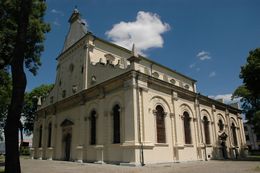

Zamość [ˈzamɔɕt͡ɕ] (Yiddish: זאמאשטש, Zamoshtch) is a town in southeastern Poland with 66,633 inhabitants (2004), situated in the Lublin Voivodeship (since 1999). About 20 kilometres from the town is the Roztocze National Park.
The historical city centre was added to the UNESCO World Heritage List (in 1992).
Contents |
History
Zamość was founded in the year 1580 by the Chancellor and Hetman (head of the army of the Polish-Lithuanian Commonwealth) Jan Zamoyski, on the trade route linking western and northern Europe with the Black Sea. Modelled on Italian trading cities, and built during the Baroque period by the architect Bernardo Morando, a native of Padua, Zamość remains a perfect example of a Renaissance town of the late 16th century, which retains its original layout and fortifications (Zamość Fortress), and a large number of buildings blending Italian and central European architectural traditions. The Old City quarter of Zamość has been placed on the UNESCO list of World Heritage Sites.
The city was a large center of Chasidic Judaism. The Jewish population in 1900 was 7,034.[1] In 1942, Zamość County, due to its fertile black soil, was chosen for further German colonisation in the General Government as part of Generalplan Ost. The city itself was initially to be renamed "Himmlerstadt" (Himmler City), later changed to "Pflugstadt" (Plough City), and the German occupiers had planned the relocation of at least 60,000 ethnic Germans in the area before the end of 1943. Before that, a "test trial" expulsion was performed in November 1941, and the whole operation ended in a pacification operation, combined with expulsions in June/July 1943 which was code named Wehrwolf Action I and II. Around 110,000 people from 297 villages were expelled. Around 30,000 victims were children who, if racially "clean" (i.e. had physical characteristics deemed "Germanic") were planned for germanisation in German families in the Third Reich. Most of the people expelled were sent as slave labour in Germany or to concentration camps.
Local people resisted the action with great determination; they escaped into forests, organised self-defence, helped people who were expelled, and bribed kidnapped children out of German hands. Until the middle of 1943, the Germans managed to settle 8,000 colonists, the number increased by a couple of thousand more in 1944. This settlement was met with fierce armed resistance by Polish Underground forces (see Zamość Uprising). The current President of Germany Horst Köhler was born to a family of German colonists in Skierbieszów.
After World War II, Zamość started a period of development. In the 1970s and 1980s the population grew rapidly (from 39,100 in 1975 to 68,800 in 2003), as the city started to gain significant profits from the old trade routes linking Germany with Ukraine and the ports on the Black Sea.
During the years 1975–1998 Zamość was the capital of Zamość Voivodeship.
Noted conservator and artist Professor Wiktor Zin was responsible for the design and oversight of conservation work on the Arsenal and the Armenian quarter in Zamość.
Education
There are 9 secondary schools: 7 public (numbered from 1 to 7 ), one Catholic and one Social school .
There are 10 primary schools: 8 public (numbered from 2 - 4 and from 6-10) as well as a Catholic and a Social primary school.
High Schools
- I Liceum Ogólnokształcące im. Jana Zamoyskiego
- II Liceum Ogólnokształcąse im. M. Konopnickiej
- III Liceum Ogólnokształcące im. K. C. Norwida
- IV Liceum Ogólnokształcące im Armi Krajowej
Colleges
- Wyższa Szkoła Humanistyczno-Ekonomiczna im. Jana Zamoyskiego
- Wyższa Szkoła Zarządzania i Administracji
- Państwowa Wyższa Szkoła Zawodowa w Zamościu
- Zespół Kolegiów Nauczycielskich w Zamościu
- University of Life Sciences in Lublin - faculty in Zamość
Economy
The city is located on the broad gauge railway line linking former Soviet Union with Upper Silesian coal and sulphur mines as well as less than 60 kilometres from the border crossings to Ukraine. Also, Zamość is located on a regular rail line, although it is not electrified. The economy of the city is based on services that is why it is dominated by numerous small and medium-sized enterprises. However, there are some large production plants, mainly food factories and companies, which is related to the dominance of agriculture in the region. These include: the Zamojskie Wheat Company (Zamojskie Zakłady Zbożowe), the Animex fodder company, the Mors frozen food producer, and a daughter company of the Dairy in Krasnystaw.
The city is also a center of know-how support for agriculture and a market for various agricultural products. In addition, the other companies include: a daughter company of the Black Red White furniture company (former Zamojskie Furniture Company), the Spomasz Zamość SA industrial and metal hardware producer, the SIPMOT agricultural machinery producer (a branch of the SIPMA Group from Lublin and a branch of Stalprodukt (former Metalplast) - producer of metal hardware and equipment from Bochnia, listed on the Warsaw Stock Exchange.
Culture
The Old Town together with the remains of the old Zamość Fortress constitute an urban complex inscribed on the UNESCO World Heritage Site. Zamość hosts the following cultural events: concerts of music performed by the Karol Namysłowski Symphonic Orchestra in Zamość and by Polish artists representing different kinds of music, Zamość Days of Music (Zamojskie Dni Muzyki) and International Meetings of Jazz Singers (Międzynarodowe Spotkania Wokalistów Jazzowych), which is a tribute to Mieczysław Kosz, a great blind jazz player and composer who used to combine his jazz music with the Polish folk.
Jazz na Kresach is a very popular annual music festival. It dates back to 1982 and has been held since then. This year the concerts are held on 28-29 May. The festival is organised in Zamość Old Town by the Zamość Jazz Club to commemorate Mieczysław Kosz.
The Zamość Festival of Mark Grechuta aims at commemorating his works. He was a composer, singer and poet. The festival has already taken place 3 times: 7-8 September 2007, 6-7 September 2008, 4-6 September 2009. The laureates of the competition and various well-known musicians sang at this festival. The festival is held in Zamość Great Market.
In addition, the admirers of open-air performances can enjoy the Zamość Summer Theatre (Zamojskie Lato Teatralne) whereas enthusiasts of folk art can relish the performances of folk groups from all over the world during the annual "EUROFOLK" International Folk Festival. Lovers of film-making can broaden their knowledge during the Summer Film Academy and the "SACROFILM" International Religious Film Days.
Politics
Biała Podlaska/Chełm/Zamość constituency
Members of Parliament (Sejm) elected from this constituency Sławomir Zawiślak - Prawo i Sprawiedliwość
Sports
Zamość is home to a soccer team Hetman Zamość.
Famous people from Zamość
- Joseph Epstein
- Szymon Szymonowic
- Marek Grechuta
- Bronisław Huberman
- Rosa Luxemburg
- Isaac Leib Peretz
- Gryzelda Konstancja Zamoyska
- Jan "Sobiepan" Zamoyski
- Marta Dzwigaj
Literature
Fritz Stuber, "Notes on the Revalorization of Historic Towns in Poland", in Ekistics (Athens), Vol. 49, No. 295, 1982, pp. 336–341, 3 ill.
International relations
Twin towns — sister cities
Zamość is twinned with: OWHC cities as well as:
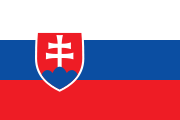 Bardejov, Slovakia
Bardejov, Slovakia Loughborough, England, United Kingdom
Loughborough, England, United Kingdom Schwäbisch Hall, Germany
Schwäbisch Hall, Germany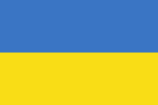 Sumy, Ukraine
Sumy, Ukraine Zhovkva, Ukraine
Zhovkva, Ukraine
See also
- Akademia Zamojska
- Seven Wonders of Poland
- Zamość Synagogue
References
External links
|
|||||||
|
||||||||||
|
||||||||||||||

